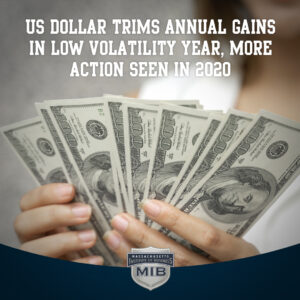SYDNEY (REUTERS) – The United States dollar was on the defensive on Monday (Dec 30) in light year-end trading after suffering a setback the previous session, as hopes of a US-China trade deal lifted investors’ risk appetite, sapping safe-haven demand for the greenback.
The US dollar index was stable at 96.942 against six major currencies after sliding 0.6 per cent on Friday for its biggest single day percentage drop since June.
With Friday’s loss, the index’s gains for the year have shrunk to under 1 per cent, putting it on track for the smallest annual change in six years.
Against the Japanese yen the US dollar was treading water at 109.41, on track to end the year where it started in January.
The big gainers in recent weeks have been the risk-sensitive and commodity-linked currencies of Australia and New Zealand.
The Aussie and the kiwi scaled five month peaks on Monday to US$0.6990 and US$0.6717 respectively, boosted by higher commodity prices and expectations the US and China would sign a trade deal soon.
Last week, Chinese authorities said Beijing was in close contact with Washington about an initial trade agreement. Prior to those comments, US President Donald Trump had talked up a signing ceremony for the recently struck Phase One trade deal.
But despite recent rallies, the annual performances of the antipodean currencies are still dreary with the Aussie down 1 per cent so far this year and the kiwi off a shade.
“What’s really noticeable is the narrow range of currencies during the year,” said Marshall Gittler, Cyprus-based chief strategist at ACLS Global, pointing to “economic and monetary policy convergence”.
“I expect less of both in 2020, for two reasons,” he said, noting the expected end of the Sino-US trade war which should lead to broader economic recovery across the world.
“As (inflation) accelerates, countries are less likely to cut rates and maybe, possibly, conceivably some countries could start thinking about hiking rates, which would encourage monetary policy divergence.”
Elsewhere, the euro rose for a sixth straight session on Monday to US$1.1186.
Bleak European economic data had prompted hedge funds to bet on a weaker euro during 2019, but some strength in recent Eurozone data along with weakness in other currencies have lifted the euro.
The common currency has jumped 2.6 per cent in this quarter but that was still not enough to wipe out this year’s losses.
Sterling was higher after European Commission President Ursula von der Leyen said the European Union may need to extend the deadline for talks about a new trade relationship with Britain.
Even with the recent United Kingdom general election smoothing the path for Britain’s exit from the EU, Britain’s ability to strike a new trading deal between the EU in a relatively short span of time remains a concern for some investors.
The pound was last up 0.15 per cent for its fifth straight session of gains at US$1.3096.
Later in the day, investors will stay tuned for the Chicago Purchasing Management Index, also known as the Chicago Business Barometer for clues about the health of the US economy.








Leave a Reply
You must be logged in to post a comment.